Kitchen Project #142: All About White Chocolate
Octavia is back to ask the important questions
Hello,
Welcome to today’s edition of Kitchen Projects. Thank you so much for being here.
Today, our chocolate columnist Octavia Lamb is back to ask (and answer) one of the pastry world’s most contested questions: Is white chocolate… actually chocolate?
Over on KP+, you’ll find Octavia’s recipe for white chocolate mousse - a rich, airy delight to go with ALL the summer fruits. Click here to make them.
What’s KP+? Well, it’s the level-up version of this newsletter. By joining KP+, you will support the writing and research that goes into the newsletter (including the commissioning - and fair payment - of all the writers), join a growing community, access extra content (inc., the entire archive) and more. Subscribing is easy and only costs £6 per month or just £50 per year (£4.10 per month). Why not give it a go? Come and join the gang!
Love,
Nicola
All About White Chocolate
by Octavia Lamb
This is a deep dive of cosmic proportions, brace yourselves. It is time to bypass many of the universe’s main mysteries (do aliens exist? Will Rhianna ever release another album?? IS IT TRUE THAT NICOLA CAN FIX A SPLIT GANACHE JUST BY LOOKING AT IT???) and go straight to the most fundamental question of our shared existence: is white chocolate even chocolate?
To answer this, we will be putting this misunderstood member of the chocolate family in the spotlight and hearing what it has to say for itself. We’ll follow it through time from its earliest, somewhat suspect, ancestors up to the white chocolate we know today. We’ll study its composition and behaviour in relation to other chocolate, and consider the myriad ways in which it is keen to work hand in hand with many of your favourite flavours.
By the end of this exploration, it’ll be up to you to decide whether this sweet, creamy, melt in the mouth ingredient deserves its perch on the chocolate family tree. But also, and perhaps more importantly, whether it’s time to welcome it back into your kitchen with open arms, or whether it deserves to be firmly locked away in the childhood memories. Of course there’s the third option that, just like me, your relationship has always been an uncomplicated and happy one. In which case, sit back, relax and enjoy.
For the white chocolate lovers amongst us, and hopefully a few new converts, we’re advancing onto Level 2 Chocolate Making, with a hand dipped double layered yuzu cheesecake chocolate. Over on KP+ I’ll be sharing the recipe for a white chocolate & mascarpone mousse, which pairs delightfully with much of the wonderful fruit coming into season over the next few months such as honey mangoes, tart raspberries or blackberries.
Chocolate Maths
First stop, a quick refresher course in the building blocks of chocolate:
Dark Chocolate = cocoa mass 40% + cocoa butter 30% + sugar 30%
Milk Chocolate = cocoa mass 30% + cocoa butter 20% + sugar 30% + milk powder 20%
White Chocolate = cocoa butter 40% + sugar 30% + milk powder 30%
The crux of this meteoric issue is the absence of cocoa mass in white chocolate. Cocoa mass is the element which gives chocolate its colour, unmistakable flavour, and unique chemical composition, being the element that carries many of dark chocolate’s health benefits. White chocolate may not be offered superfood status any time soon, but that’s ok! It’s still a confection derived from the hallowed cocoa pod, just like its dark and milk brethren, and deserves to be known as chocolate, in my opinion.
But what do the chocolatiers have to say about it? Joanna Brennan of Pump St., award-winning bakers and craft chocolate makers, explains that “For us at Pump Street, our white chocolate is most certainly chocolate as we make it from the cocoa bean, to the finished bar, pastille or baton, and we do this with single farm cocoa beans.” Aha! Go on... “By pressing our own butter, which is not deodorised, we ensure that some of the character of the whole bean remains in the chocolate. With high cocoa butter content, and a balance of milk and sweetness, the result is smooth with tasting notes of custard and cold buttermilk.”
But, if this is still not enough for you (jeez!), the might of His Majesty’s Government is also on my side! I know it’s a little early in the day for this level of excitement (and I hope you’re sitting down), but I’d now like to draw your attention to The Cocoa and Chocolate Products (England) Regulations 2003.
“White chocolate: The product obtained from cocoa butter, milk or milk products and sugars which contains not less than 20 per cent cocoa butter and not less than 14 per cent dry milk solids obtained by partly or wholly dehydrating whole milk, semi-skimmed or skimmed milk, cream, or from partly or wholly dehydrated cream, butter or milk fat, of which not less than 3.5 per cent is milk fat.”
So, as long as long as we keep the cocoa butter content above 20%, it’s chocolate, and not just a “cocoa butter confection, or sweet cocoa butter coating”. When you take the cocoa butter out of the equation completely, or exchange it for palm oil, you’re then left with what are known as “white candy melts”, the kind of imposter chocolate buttons that can be melted down, poured and set without tempering, but they belong in a universe I do not wish to enter.
Potted White Chocolate History
Given that chocolate has existed in some form since around 1400BC(!), it is reasonable to call white chocolate a relative newcomer. Recipes for “white chocolate” started popping up from as early as 1869, and they are fantastically Victorian*. For example, in 1871 Henry Blake shared a recipe for white chocolate in his chemist’s manual The Druggist’s General Receipt Book which contained “white sugar, rice flour, arrowroot powder, vanilla, cocoa butter, and gum arabic” – which would’ve produced a fairly chewy confection. Fortunately, we’ve since managed to make do without the flour, arrowroot and gum.
White chocolate isn’t alone in its predecessors being fairly unhinged. When drinking chocolate arrived in Europe, the upper classes went wild creating their own recipes, many of which were deemed so delicious, they were kept under lock and key. Cosimo Medici the 3rd (1642- 1723) had his personal physician make his own secret hot chocolate recipe which contained the following:
10lb toasted cacao beans, cleaned and coarsely crushed
Fresh jasmine flowers
8lb white sugar, well-dried
3oz “perfect” vanilla beans
4 to 6oz “perfect” cinnamon
2 scruples ambergris (a substance found in the digestive system of sperm whales, delightful. Ps. Bring back scruples as a measurement)
A spoonful of sugar helps the medicine go down!
Mary Poppins knew it. So did Nestle. The origins of white chocolate as we know it today can, of course, be found in a… children’s “medicine”.
Nicola once mused with me that white chocolate was effectively like a solid condensed milk, and it turns out she wasn’t wrong! In 1936 Nestle teamed up with the pharmaceutical company Roche to create Nestrovit, a vitamin enriched condensed milk to boost children’s daily nutrition (now this is my kind of health supplement). Nestrovit was designed to be taken in pill form, so Nestle created a protective sweet cocoa butter coating.
Eventually, Nestle saw an opportunity to scrap the nutritional element altogether, and produce his own, brand new, milk-forward cocoa butter confection. And so the first white chocolate bar was put into production, the Galak Bar (as it is still known in some countries), which eventually became known as the Milkybar! Other than when it was taken out of production during WW2 owing to limited rations, it has remained a staple in every corner shop and supermarket ever since.
For a pretty inoffensive foodstuff, white chocolate seems to have managed to leave a trail of outrage and hysteria in its wake throughout the ages. When the totally scandalous rumours of a new-fangled white-coloured chocolate reached the ears of one T.B. McRoberts in 1916, he decided to address this (and pedal some pretty hefty rumours of his own!!!!) in the International Confectioner Magazine as follows:
“I never saw snow-white chocolate, but I would rather see than eat it. The only possible way to produce such a thing would be to bleach the cocoa elements entirely with some "bleaching agent," as for instance clorine gas [sic]. This is produced by the action of sulphuric acid on chloride of sodium (common salt). It is the "poison gas" of the trenches which the warring armies jet at each other in order to smother their foes ... It would possibly take more than twenty days to bleach cocoa to "snow white," and I hardly think its flavor would be improved by the process, if indeed any flavor at all remained, which is very doubtful. The Swiss have introduced many novelties in chocolate as I have noted, but I hardly think that they would waste time and effort on so foolish a thing as "snow white chocolate"; a thing for which there can be no good reason existing. Why paint the lily?”
Burn.
Whilst I won’t speak ill of HRH The Milkybar Kid, Milkybar perhaps has a bit to answer for when it comes to some peoples’ withering opinions of white chocolate. Many people’s experiences with white chocolate don’t go much further than the aforementioned OG, with ~53% sugar, plus emulsifiers, sweeteners and flavourings, and if your tooth isn’t on the sweetest end of the spectrum this may not appeal (side note: NO JUDGEMENT to those who take joy in the occasional cube or 10 of this particular corner shop classic, the heart wants what it wants and who am I to stand in your way).
The new era of white chocolate
However, in recent years there has been an uptake in craft white chocolate production, giving us a few slightly more grown up alternatives.
The key differences between a mass produced white chocolate and a craft white chocolate could be broken down as such:
Cocoa butter/ sugar content. Cocoa butter is an expensive ingredient, used for all sorts of other things such as make up, skincare products and other foodstuffs. Most mass produced white chocolate will stick close to the legal minimum of 20%. This means that more of the white chocolate will be padded out with significantly more sugar, plus oils, flavourings or lecithins (the glue that producers use to stick all the ingredients together and keep them emulsified).
A common add-in in white chocolate is vanilla, which sometimes is a lovely thing! But often it’s stuck in there because without it, there isn’t really much flavour left. Valrhona Ivoire stands at 35% cocoa butter, whilst Pump Street’s single origin Hacienda Limon white chocolate leads the way with a mighty 44% cocoa butter content. As with dark or milk chocolate, look for the ones with the shortest ingredients lists as this will give best results for ganaches and temperingCocoa butter quality. In the same way that you can get deodorised coconut oil, the same process of steaming the fat to remove the flavour can be applied to cocoa butter. Most mass producers will deodorise their cocoa butter, but smaller producers are keeping the flavour in, giving their white chocolate a more individual flavour in addition to the initial creaminess.
Most importantly, I’d encourage you to do a little side by side tasting to see the difference between supermarket and craft white chocolate for yourself. It is quite remarkable.
White Chocolate – a Mirrorball
White chocolate is a chocolatier’s flexible friend. To use Taylor Swift’s terminology, white chocolate tends to be something of a mirrorball in the kitchen, it’s all about making other flavours glisten, and it’s out there working overtime to earn its place in the kitchen.
Two of my favourite uses for white chocolate happen to be delightfully oxymoronic:
To soften sharpness (citrus, passionfruit, raspberry)
To sweeten bitterness (coffee, matcha)
But that’s not it, it’s also the perfect for enhancing creaminess (mascarpone, coconut, clotted cream or cream cheese), it allows softer flavours their moment in the spotlight (pistachio, vanilla, macadamia) and lastly it also partners well with fresh herbs (bay, basil, tarragon), and spices (cardamom, pink peppercorns, and fennel- as demonstrated in Nicola’s own delicious fennel and white chocolate cookies).
Its compatibility both with sharp fruits and creamy coconut is what makes it the natural choice when it comes to creating tropical flavours. Or perhaps use a combo of white chocolate and hazelnut to create your own Kinder Bueno vibes gianduja.
Behaviours
For those STILL unconvinced that white chocolate is deserving of its seat at the table, it also walks and talks just like the other varieties, and even has some unique party tricks up its sleeve (guys, come on, it’s trying so hard here).
The high amount of cocoa butter in white chocolate means a few things. Firstly it has the signature snap just like milk and dark chocolate, and tempers like a glossy little dream. Secondly, the concentration of cocoa butter and milk solids also means that white chocolate is by far the most fluid to work with, with a working temperature (tempered) of 27-29 degrees, compared to dark chocolate at 30-31 degrees. You can easily create paper thin chocolate shells for bonbons, or moulded mousses for a petit gateau.
As we know, the classic ratio, and the usual jumping point for a classic dark chocolate ganache is a 1:1 double cream to chocolate mix. Owing to its fluidity, if you apply the same ratio to white chocolate, you will create soup. To get a truffly set on a white chocolate ganache, start at 40g double cream to 100g white chocolate, but as we’re using such a small amount of warm cream, I’d recommend pre-melting your white chocolate to make sure you’re not left with unmelted floating chunks.
I’ve said it before and I’ll say it again, chocolate can be a harsh mistress. White chocolate is no different, if anything it needs an extra gentle touch. With the absence of cocoa mass, and the larger proportion of milk solids and cocoa butter, white chocolate has a lower melting point, which is why you only take it to 40/45 degrees max, whereas dark chocolate can be taken up to 45/50 degrees. This also means it has a lower burning point, so a gentler touch is needed to make sure you don’t scald and ruin a batch of ganache by pouring over boiling cream (this is a purgatory from which there is no return, unfortunately).
Party Trick!
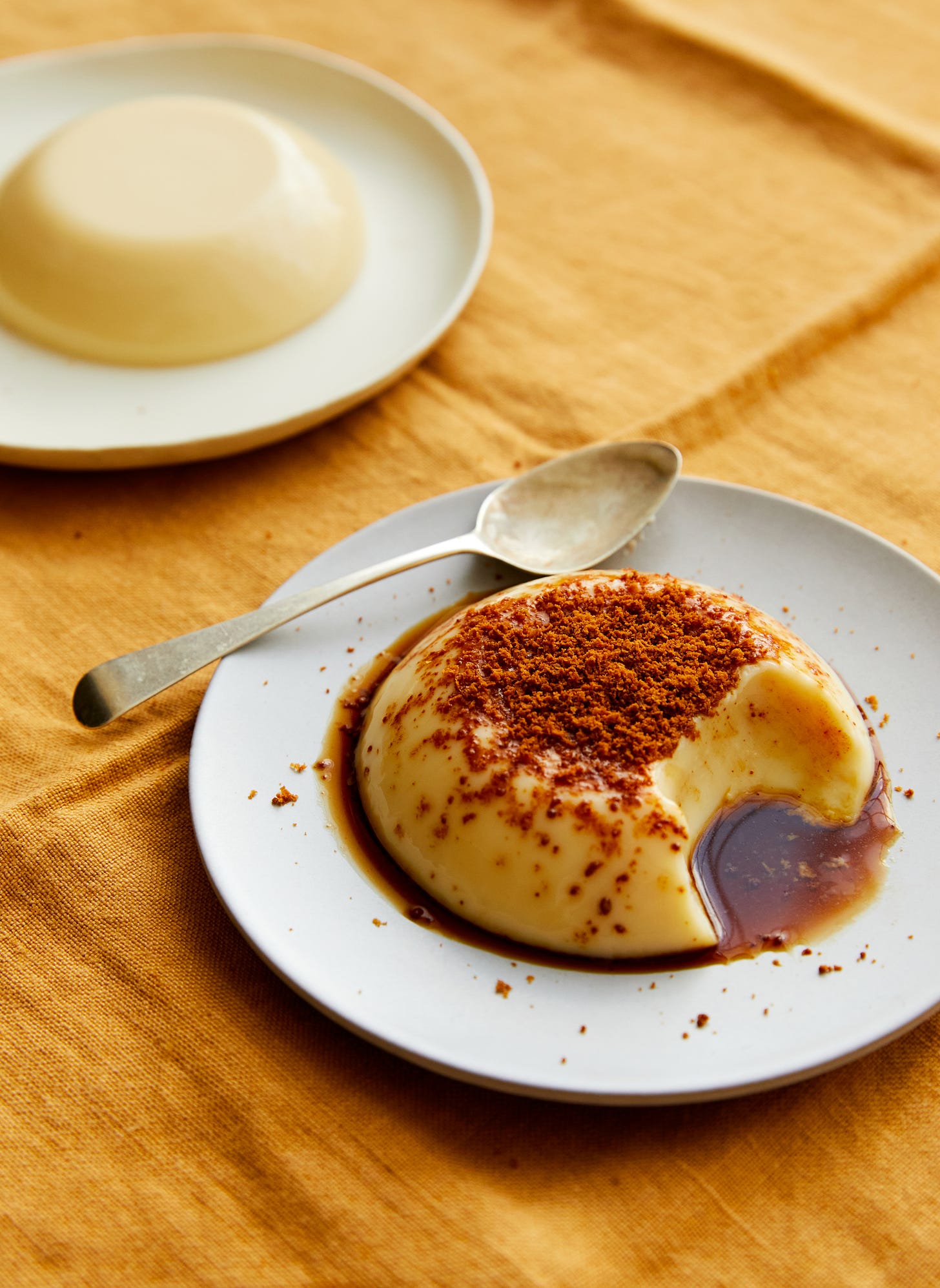
The high quantity of milk solids in white chocolate can also be harnessed to create blonde / gold / toasted / roasted / TECHNICALLY MALIARDED white chocolate, which is another story entirely. Nicola has even gone a step further recently to pioneer her own burnt white chocolate as an ultra-umami-crumbly-topping-of-joy to accompany her milky panna cotta in Sift.
Working with White Chocolate
We’ve touched on the OG white chocolate, Milkybar, and whilst this may be a nostalgic favourite, and mainstay of the corner shop chocolate bar selection, it’s unfortunately not the one we want to be working with when it comes to creating your own white chocolate delights.
As with other mass produced chocolate bars found on supermarket shelves, Milkybar contains a few more ingredients than we’d like, as such it’ll likely lead to unpredictable, inferior results, so leave the childhood memory alone and instead opt for something a little more reliable.The chocolates I’ve listed below are all delicious, fantastic white chocolates whilst also all coming from producers working to high ethical standards.
Good white chocolate for baking with:
Valrhona, Ivoire 35% or Opalys 33%
Original Beans Yuna Edel Weiss 37%
Pump Street Hacienda Limon 44%
In summary, it walks like chocolate, it talks like chocolate, and works so very hard to be liked.
Yuzu Cheesecake Chocolates
Makes approx. 50 chocolates
Storage: Coated, lasts one week in an airtight container at room temperature.
Welcome to Level 2 Chocolate Making! “Cheesecake” ganaches have become increasingly popular amongst chocolatiers recently, and with good reason. White chocolate cheesecake is a classic, the tang of cream cheese partners perfectly with the sweetness of white chocolate, and what’s not to love when you can create one of your favourite puddings in tiny cube form?
On the subject of cubes, unless you have a guitar cutter, or if you are in fact a robot, these will never come out PERFECTLY uniform in size. But that’s fine.
The first layer is a biscuit base using blonde chocolate to lock in the crunchiness, amplify biscuittinnes, and to stop it from crumbling when cutting it. Technically, a crunchy layer in a chocolate should contain 0% water (from butter, cream etc) in the formula as water will find its way into any crunchy element and soften it. In this recipe I am using a small portion of butter to add to the authentic flavour of a cheesecake base, however by browning the butter first, we remove a lot of the water content, whilst also adding to the biscuitty notes with our browned milk solids. This has a low enough water content to remain perfectly crunchy for a week.
The second layer is our “cheesecake” ganache. For this we are doing away with the traditional cream and butter, and making a yuzu juice base, finishing it with cream cheese. This ganache has no extra sugar in it, but it will still last a couple of weeks as the acidity in the yuzu juice acts as a preservative here. Many chocolatiers often add a small amount of lemon juice or even vinegar to their ganaches to enhance shelf life without increasing sweetness.
A quick word on yuzu before we get going. Yuzu tastes too good to be true, it’s as if Disney created a citrus fruit. There’s something so cartoon-like about its flavour, and it’s truly one of nature’s masterpieces. The zinginess cutting through sweet creamy white chocolate here is heavenly, and my personal favourite pairing with white chocolate.
The Recipe
Biscuit Base
95g Biscuits of your choice. I’m a classic Digestive gal when it comes to cheesecake but follow your hearts and dreams. Ginger biscuits would be lovely too.
90g Blonde Chocolate (you can make it yourself)
30g Unsalted butter to make 20g brown butter
A pinch of salt to taste
Yuzu cream cheese ganache
250g Good quality white chocolate, I’ve tested this recipe with Valrhona Ivoire and Pump Street, so try to stick between 35% and 40% cocoa butter content.
50g Yuzu juice
50g Cream cheese, room temperature
A small pinch of salt
To Finish
600g of tempered white chocolate, according to these instructions.
Method
Lightly grease a 24x18cm (or as close as possible- the bigger the tray the flatter the chocolates) tray before lining with parchment paper. Do not grease the paper itself. We’re just greasing the tray to stop the parchment slipping around when you’re pressing your first layer into the tray.
Gently brown your butter in your smallest saucepan. This is such a small quantity that it will brown very quickly, so keep your eyes on it, and be ready with a heatproof bowl to transfer the butter into as soon as it’s ready to stop it burning. Set aside to cool.
Blitz your digestives in a small food processor to a fine crumb. Set this aside.
Partially melt your blonde chocolate in a small bowl either in the microwave in short bursts or over a bain marie, until about 1/3 of the chunks still remain. This took just over 2 minutes on 400 in my microwave. Remove from the heat and stir off the heat till the remaining pieces have melted, this will keep the temperature down and hopefully retain a little bit of temper to help it set quickly.
Add your browned butter and pinch of salt and stir till fully combined. Check the temperature of your chocolate mixture, it shouldn’t be above 30C. If it is, just stir it till it’s cooled. Add your ground biscuits and stir it all together.
Pour the mix into the tray and use the back of a spatula or a small offset palette knife to work it flat and even. Pop this in the fridge to set while you make your next layer.
As there is only a very small amount of liquid in this ganache, we’re going to pre-melt our white chocolate so we’re not left with any unmelted lumps.
Weigh your yuzu into a small saucepan and bring to steaming point.
Pour this into your melted white chocolate and stir it together, it should make quite a thick ganache at this point. If it looks at all like it wants to split, do not fear, the cream cheese will loosen things.
Add your cream cheese and stir it in till fully emulsified.
If you have a hand blender, now comes my favourite part. Sneak your blender into the ganache and give it a long emulsification. Not only does this enhance the texture, but if you try the ganache pre and post stick blender, the flavours become so much more pronounced once it’s been blended! See this article for why we use a hand blender rather than a whisk
Check the temperature of your ganache. We need to wait for it to cool to about 28 degrees before we pour it onto the base, or you’ll melt your first layer and undo all your good work. Leave your ganache to cool, stirring it occasionally till it’s the desired temperature.
Pour it onto your base, and smooth it out with a spatula. Give it a few gentle little bashes on the surface to even it out and then leave it in your fridge to fully set. Either a minimum of 4 hours or overnight.
When it’s fully set, lift the entire ganache out of the tray by the parchment and place it on a chopping board. Portion your chocolates into little squares ready for dipping. It helps to use your sharpest knife, wiping it in between for your cleanest cuts. Between 2cm and 2.5cm is good. Any bigger and they’ll get enormous once they’re dipped. Leave them to one side while you’re tempering your white chocolate for dipping.
Spread out some parchment paper on a chopping board next to your bowl of tempered chocolate, and have some kitchen roll to hand.
When you’re ready, use a dipping fork if you have one or a normal fork, dip your chocolates one by one into your tempered white chocolate. Tap off the excess and lower them onto the parchment paper to set.
Decorate as you please. I finished mine with a touch of gold leaf while they were setting, but you could also sprinkle on a pinch of dried zest, or nuts, or pipe some lines of tempered chocolate on top. Or bush on a layer of luster dust.





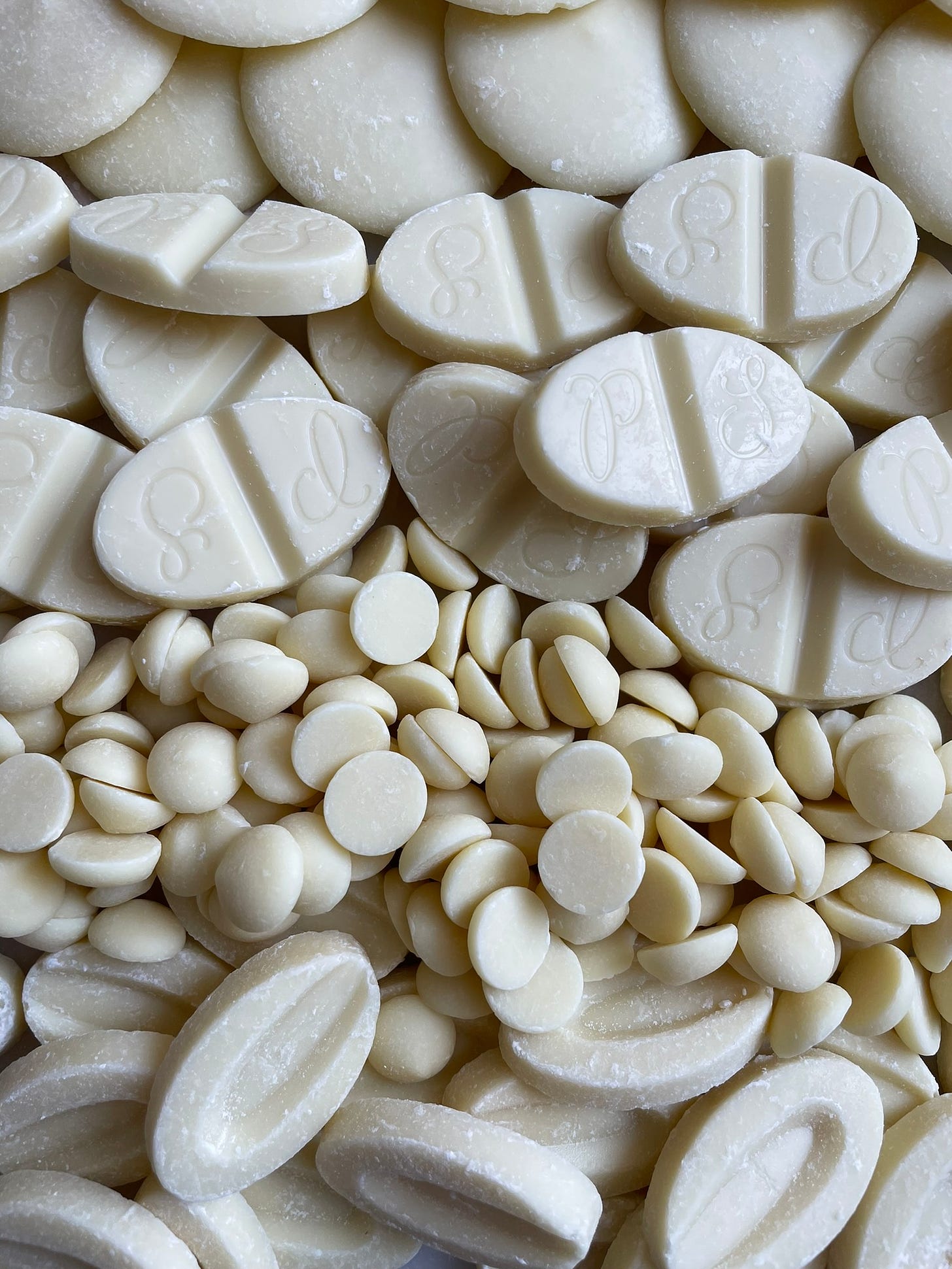
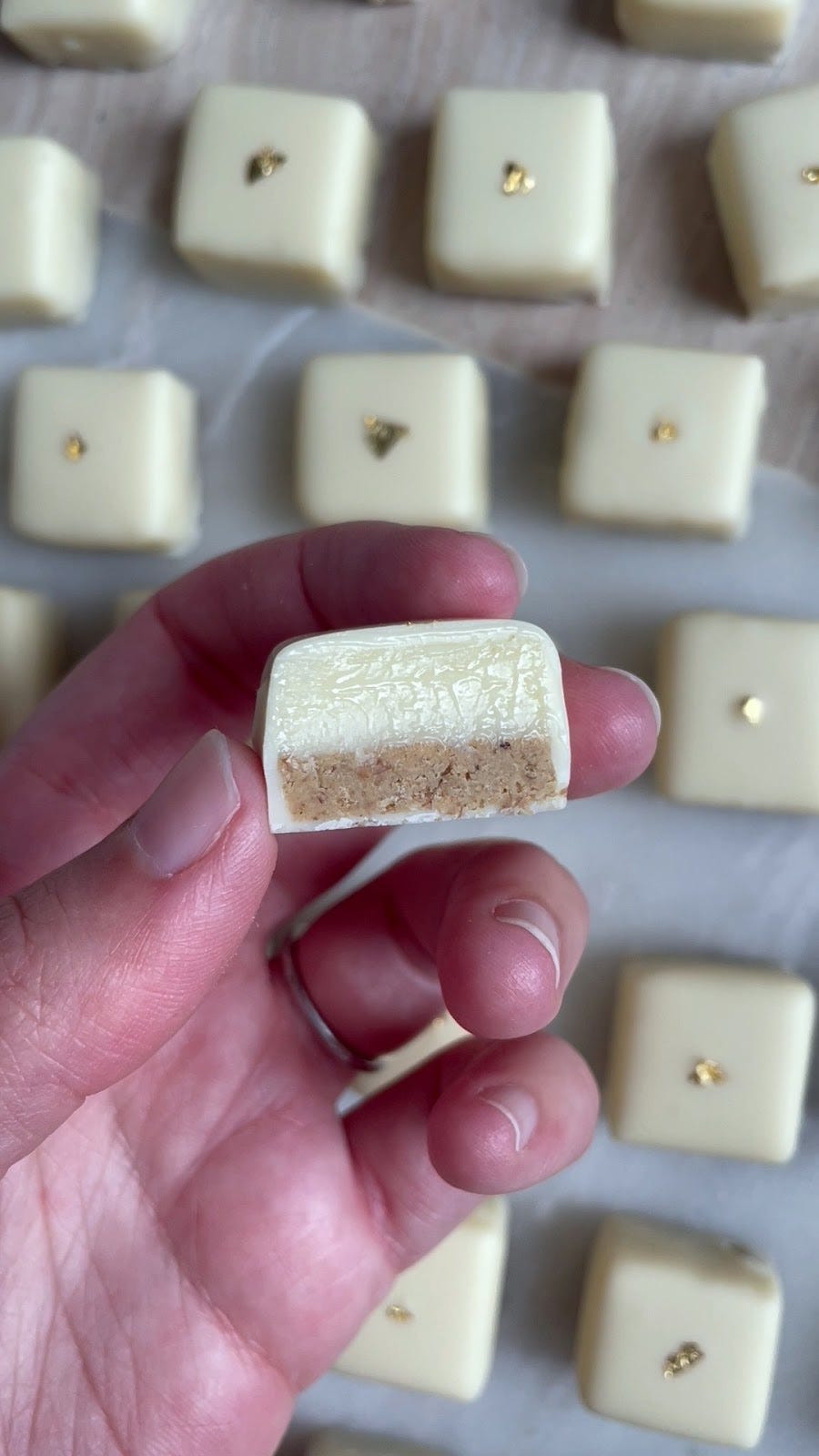
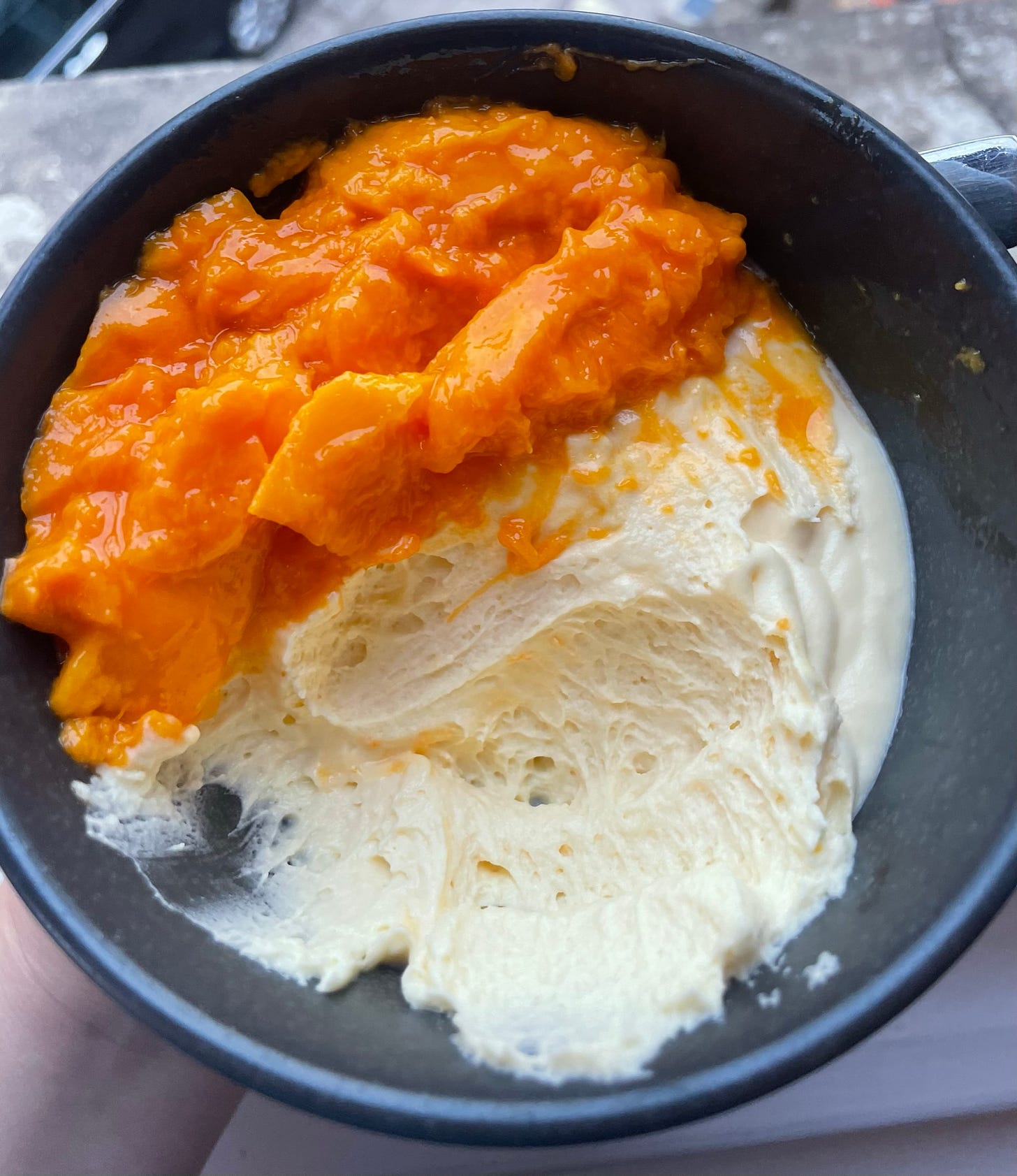

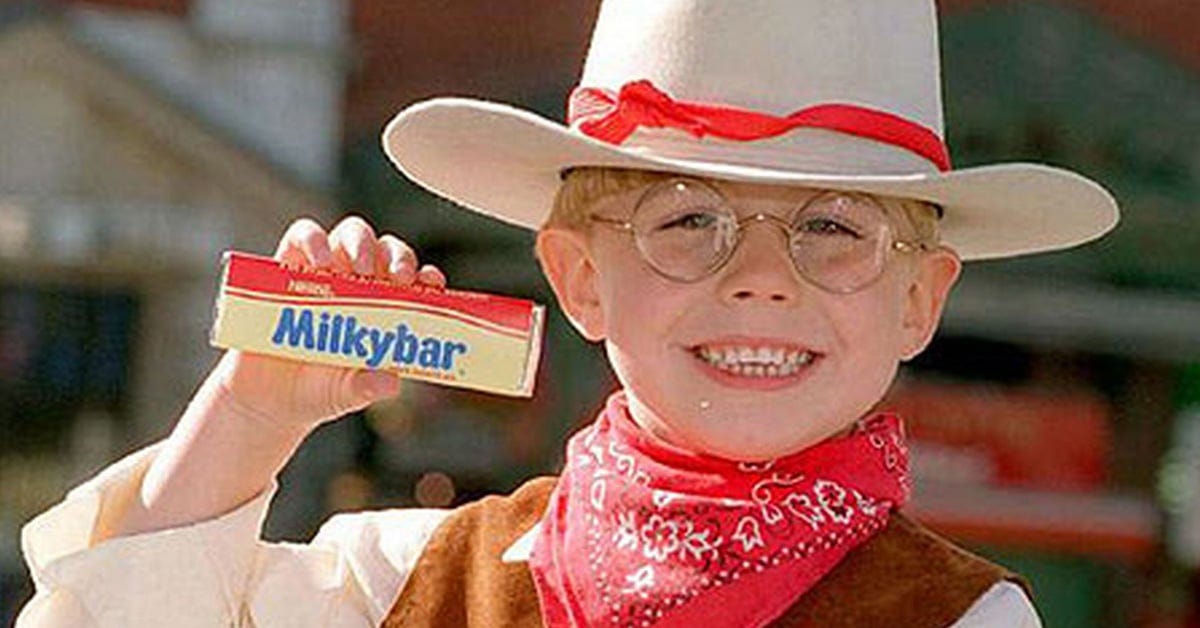
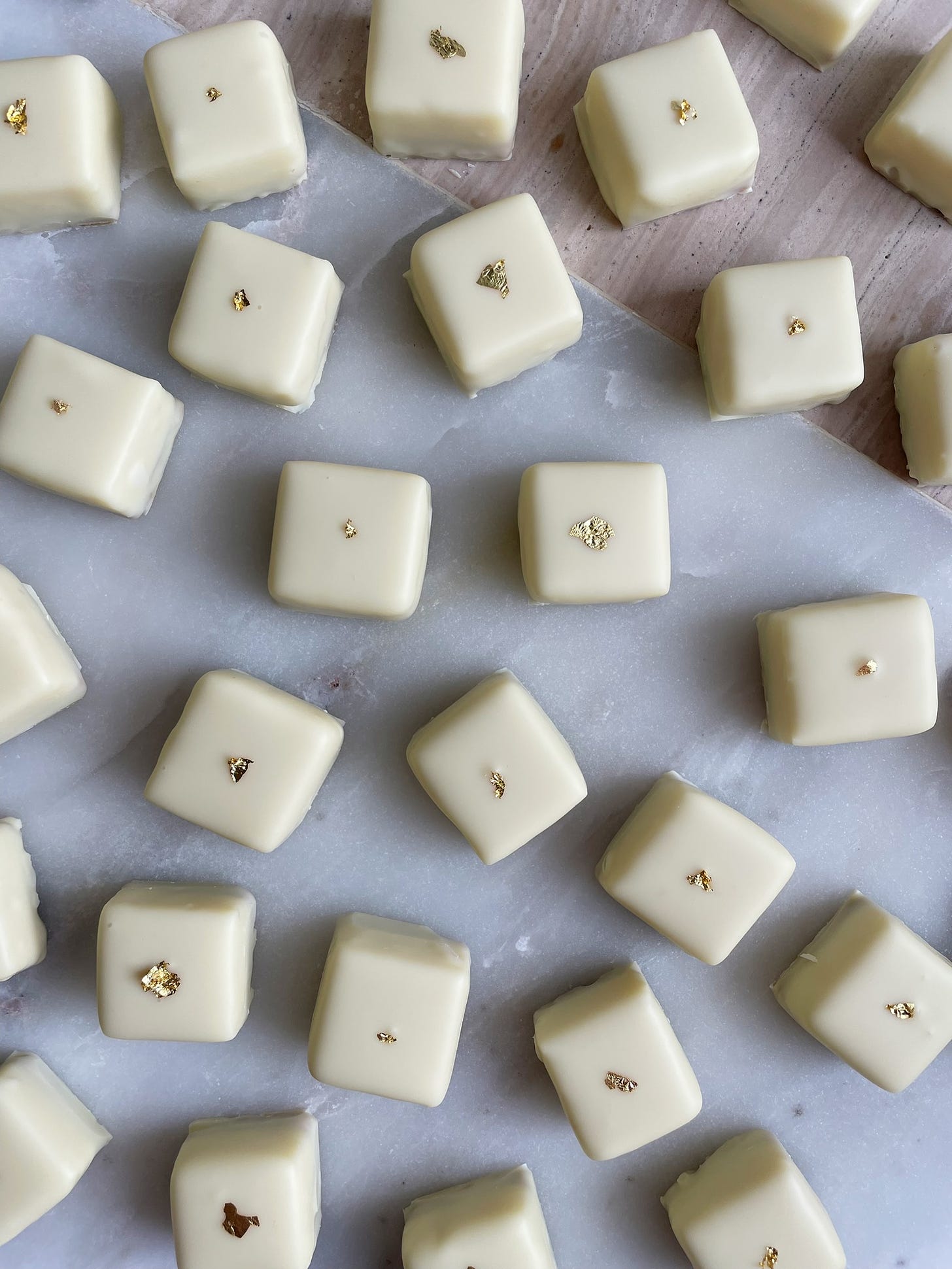
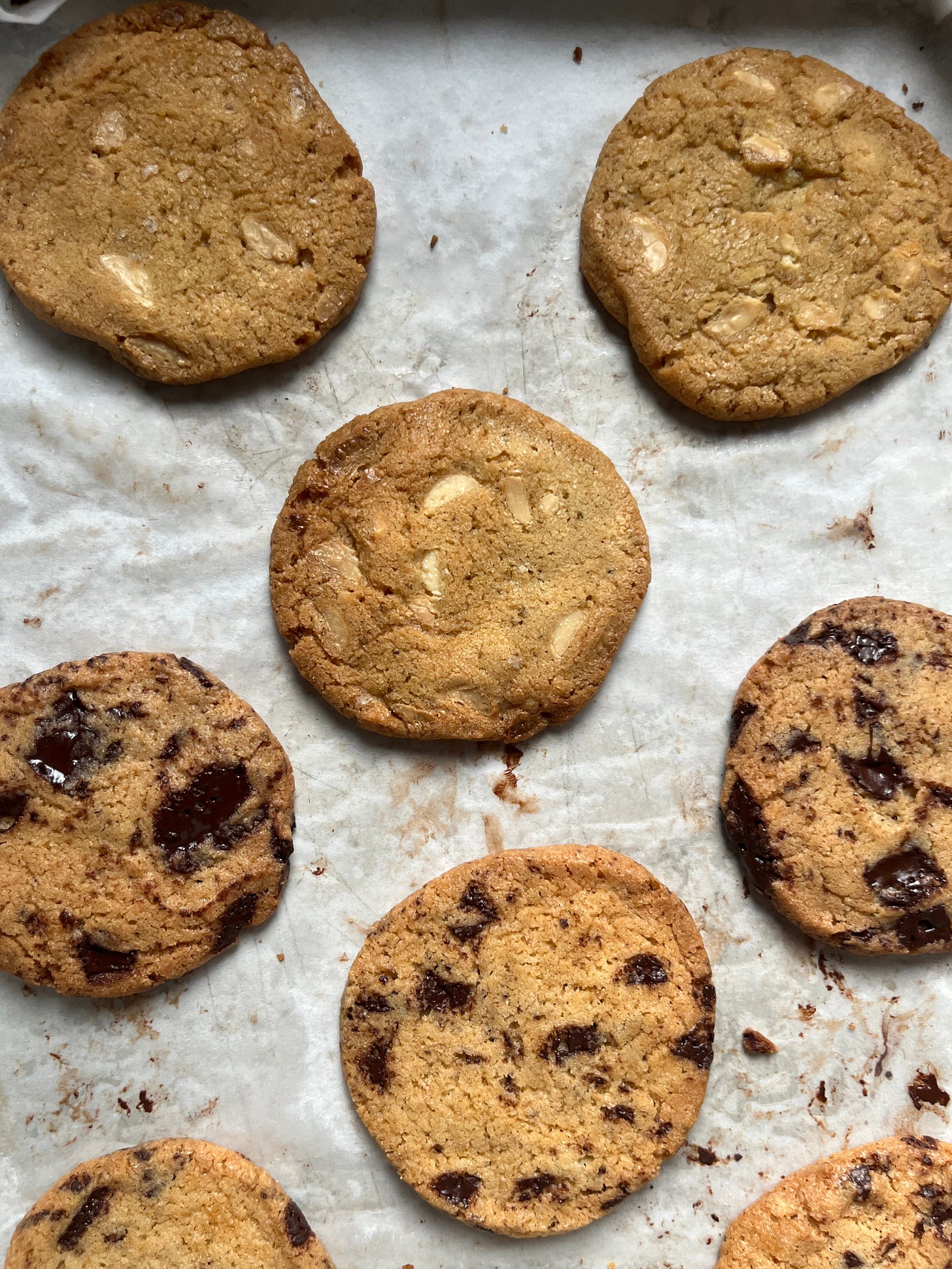
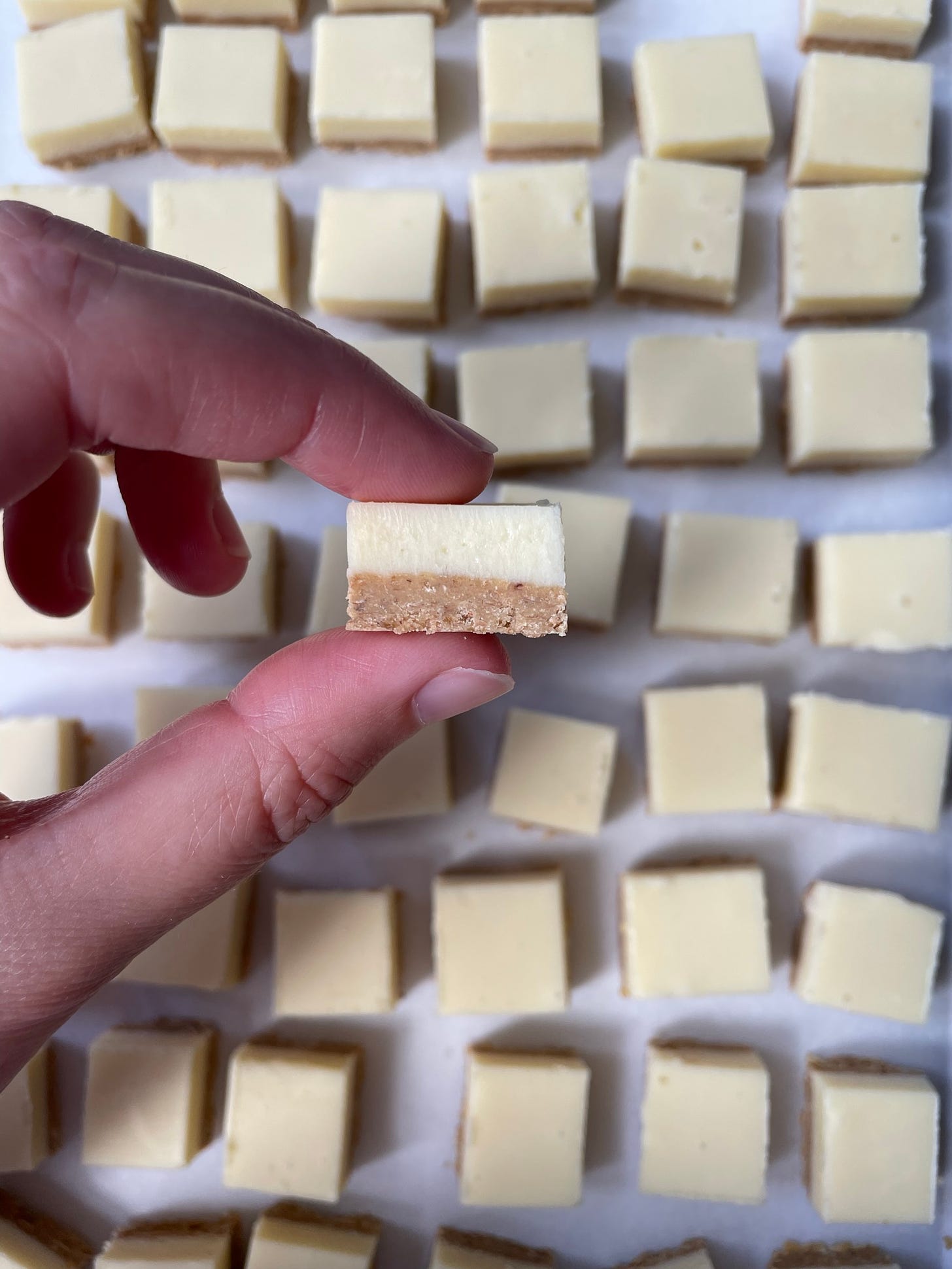
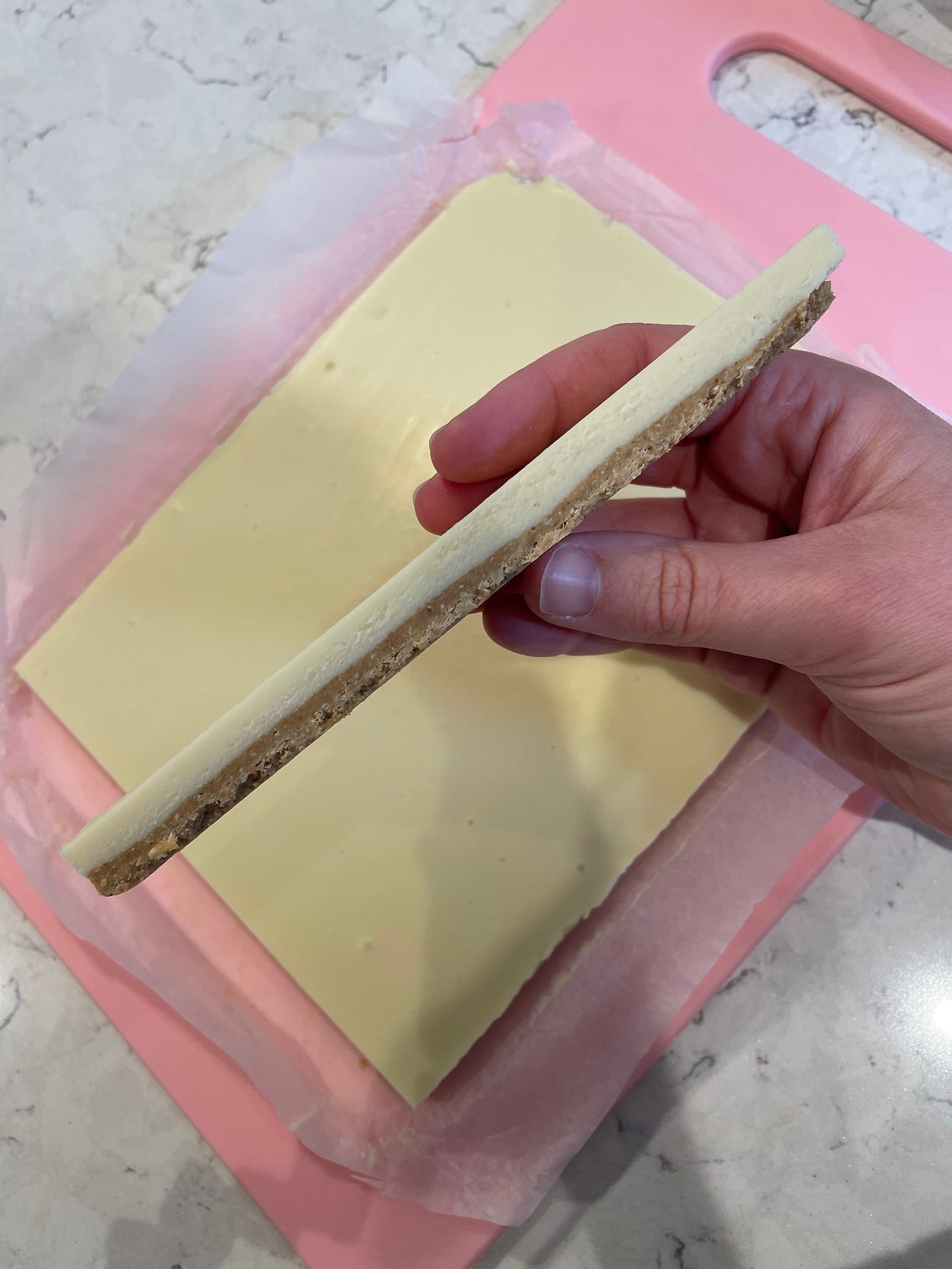
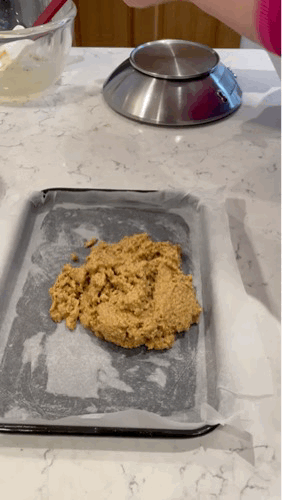
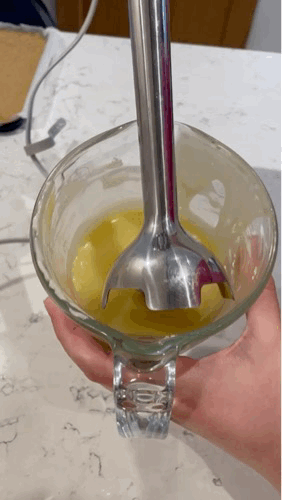

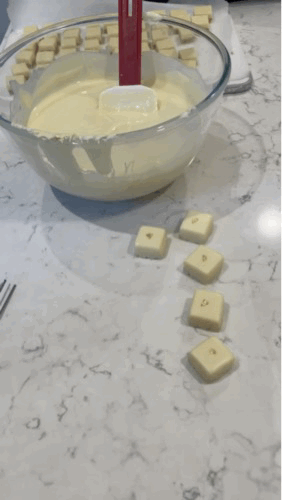
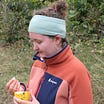
Thank you for the wonderful read. Only the blonde chocolate link is missing.
Sounds fascinating!